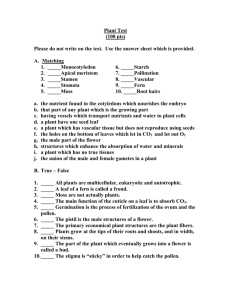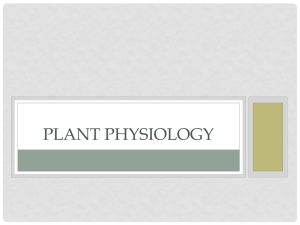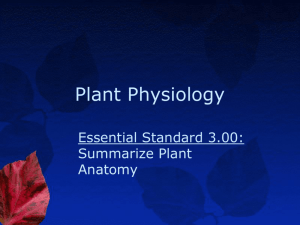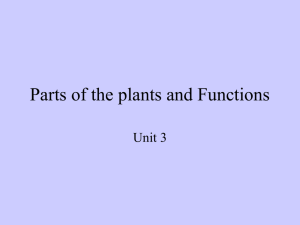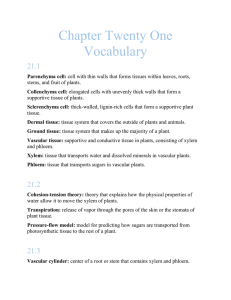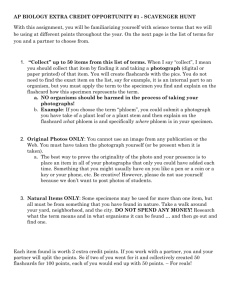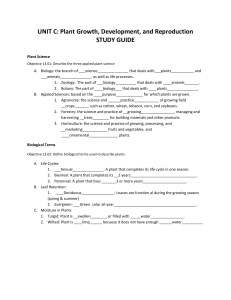PLANT SCIENCE: Botany
advertisement
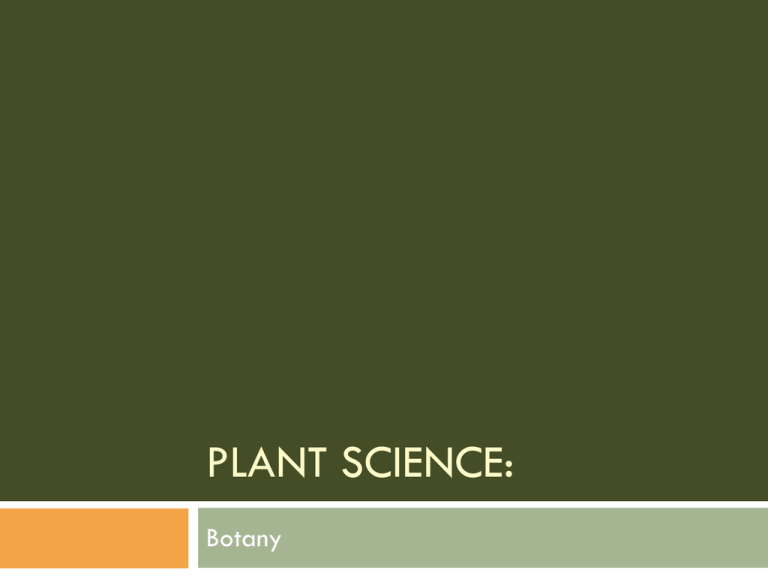
PLANT SCIENCE: Botany Plant Importance Primary food source Produce oxygen Cooling Renew air Slow wind Prevent erosion Provide shelter Beautify Building materials and fuels Parts of Plants Four basic parts: leaves, stems, roots, and flowers Flowers later become fruits or seeds Leaves: Food factory location (photosynthesis) Shape Used and size vary for identification of plants Arrangement varies Leaf Arrangement External Leaf Structure Petiole – leaf stalk Blade – larger, usually flat part of leaf Veins – form structural framework Midrib – large, central vein that all other veins extend from Margins – edges of leaves External Leaf Leaf Structures Internal Leaf Structure Cuticle – waxy covering layer Epidermis: “skin” of leaves Single layer of cells Prevent moisture loss Guard cells: Open and close pores on the underside of the leaf Stoma: Pores Allow transpiration (exchange oxygen and carbon dioxide) Leaf Structures Internal Leaf Internal Leaf Structure Chloroplasts: Green due to chlorophyll (pigment) Manufacture food through photosynthesis A process where carbon dioxide and water in the presence of light are converted into sugar and oxygen 6CO2 + 6H2O + light energy C6H12O6 + 6O2 Respiration Consume oxygen and give off carbon dioxide All plants need oxygen to all parts (including roots!) If not, can lead to death Poor drainage, over watering Plants produce more oxygen than they consume Stems Functions: Movement of materials Water and minerals up from roots Food down to roots Support of the leaves and reproductive structures Flowers, Food If fruits, seeds storage and/or production green, can use photosynthesis Reproduction: Cuttings and rafting Stems: external structure Lenticels – breathing pores Bud scale scars – where a terminal bud has been located Distance between 2 scars = one year of growth Leaf scars – where leaves were attached Terminal bud – a bud at the end of the stem Produces new growth Stem Structure Stems: internal structure Xylem – carries water and minerals UP Phloem – carries manufactured food DOWN Dicots: Plants that have 2 seed leaves (cotyledons) Xylem and phloem from 2 layers separated by cambium Produces all new cells (phloem to outside, xylem to inside) ie: trees Continues to grow as long as it lives, not limited in size Monocots 1 seed leaf ie: corn Vascular bundles: phloem and xylem tissue in a bundle All cells are formed in initial growth, cells simply expand over time Limited in size Monocot Stem Dicot Stem Monocot versus Dicot Roots Underground, not visible (usually) Functions: Anchor Absorb Store water and minerals food Reproduce (some plants) Root Internal Structure Outer phloem (corklike bark) Cambium Xylem Very similar to stem internal structure Root External Structure Root cap Produces Helps a continuous supply of new cells to push a path through soil Primary root Lateral roots Root hairs Absorb water and minerals Root Structures Root Systems: Fibrous Roots Much easier to transplant Roots are shorter, smaller and more compact Root Systems: Tap Roots Longer with fewer roots Root Systems: Comparison Flowers: types Vary in size, shape, and color Complete flower: has both male and female parts Self-fruitful Can pollinate itself Incomplete flower: has only male OR female parts Complete Flower Parts Sepal: green, leaf-like part that covers and protects the flower bud before it opens Petals: modified leaves used to attract pollinators Pollinators: insects, birds, animals, wind, etc Used to fertilize plants to produce seeds Complete Flower Parts Stamens: male reproductive organs Stalk- filament Anther- sac-like structure at top of filament Pollen- male sex cells, contained in anther Pistil: female reproductive organs Center of flower Produces eggs- when fertilized by pollen, become seeds Stigma: sticky top region, used to catch pollen Style: tube leading from stigma to ovary to transport pollen Ovary: where the egg cells develop and are fertilized After fertilization, ovary becomes a fruit or seed coat Complete Flower Incomplete Flowers: Differences Does not have both male and female parts Male: sepals, petals, and stamen Female: sepals, petals, and pistil Pollinated by same factors, but must move between flowers, not within flower Incomplete Flower The Role of Flowers Beauty Reproduction Economic value Multimillion dollar business


